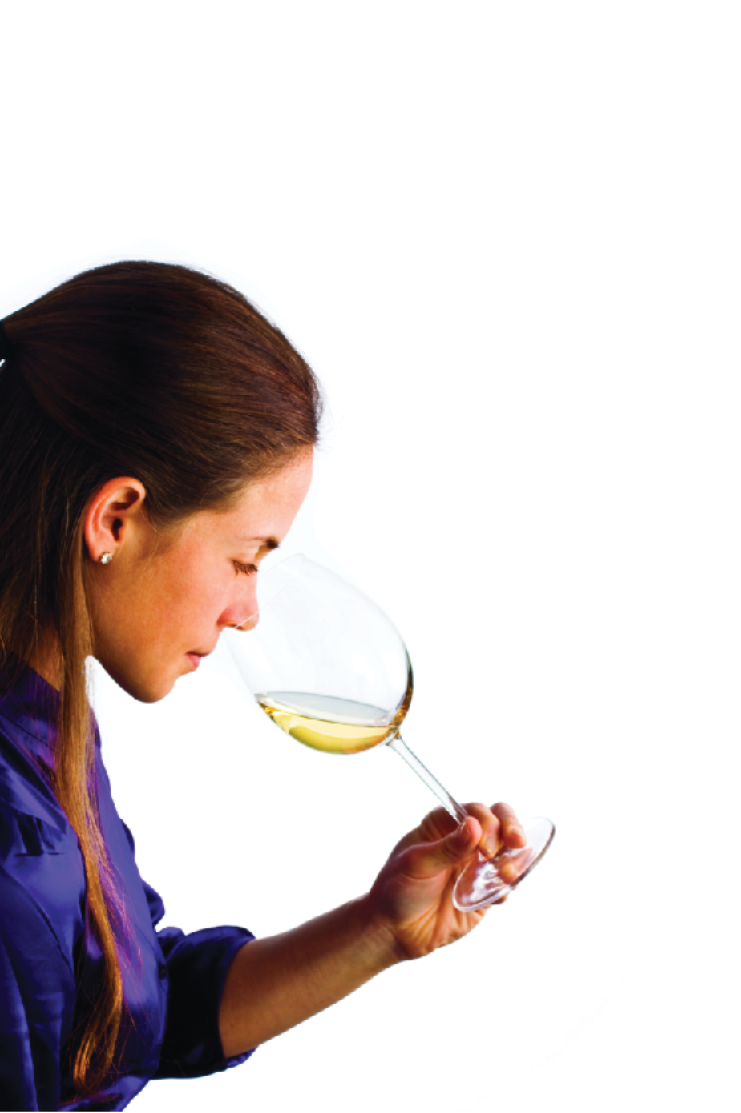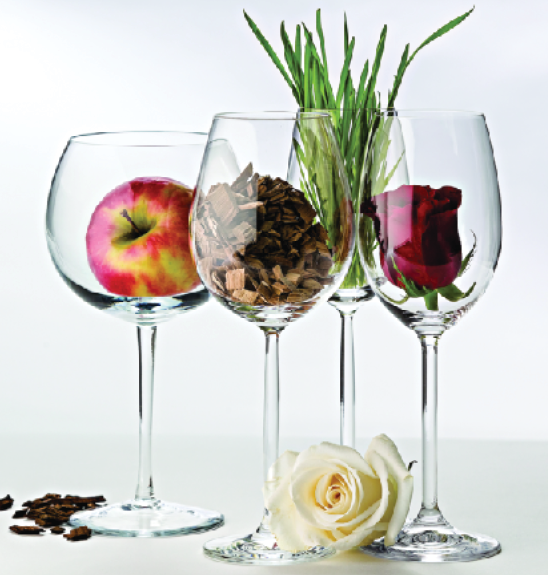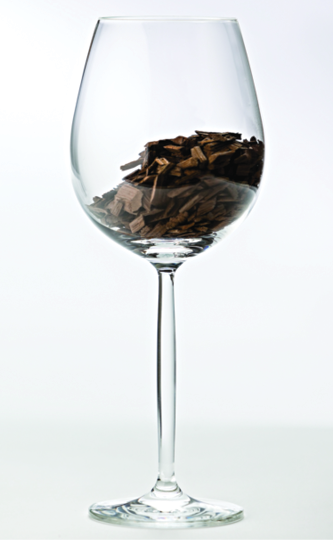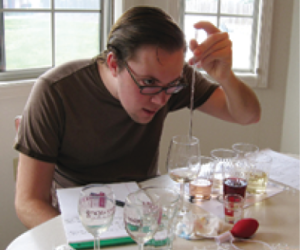
Getting and keeping attractive aromatics is a major goal of winemaking, home or commercial, and it isn’t easy. It is a goal and a concern at every step along the way, from harvest to bottle aging; it’s not something you do all at once, like tannin extraction during fermentation. The aromatic calculus for whites differs from that for reds, and aromatics in young wines are a world apart from the aromatics of well-aged wines. There are lots of places where you can do things in your home winery to amplify aroma, which are also the same places you can let them slip away.
White Wines
Some white grapes are generally referred to as aromatic varieties: floral ones, like Gewürztraminer, Muscat, Viognier, Riesling and Chenin Blanc, and the aggressively herbal Sauvignon Blanc. Any white wine will have something to smell, but these varieties are especially known and prized for their aromatics.
Riesling is a somewhat special case. While many of the aromatic varieties are dominated by a single volatile compound — monoterpenes (floral) for Muscat, methoxypyrazine (grassy) for Sauvignon Blanc, β-damascenone (rose/lychee) for Gewürz-traminer — Riesling is genetically wired to contain near-threshold levels of a broad range of odorants and aromatic precursors. Gavin Sacks and fellow researchers at Cornell University speculate that this longer roster of aromatic contenders contributes to Riesling’s legendary sensitivity to the site it is grown in; it has more ways to express itself.
Alongside the certified aromatic varieties are a number of what I call semi-aromatics — grapes that convey some of the magic of the full-tilt varieties, at least when they are made with aromatic preservation in mind. Examples here are Pinot Gris/Grigio, Albariño, Greek varieties like Moschofilero and Assyrtiko, Riesling crosses such as Scheurebe and Müller-Thurgau, and Catawba.
The point is one major variable in the quantity and quality of your wine aromatics is the grapes. Some whites won’t have much of a nose, even though they may be tasty and refreshing, even impressive. Chardonnay is the poster grape here: the base grape offers some level of vaguely appleish aromas, and just about anything beyond that comes from oak aging, malolactic fermentation, lees breakdown and bottle aging.
Once you have some aromatic material in your grapes, your next task is to pull it out and amplify or transform it in the course of fermentation. Very few of the important aromatic compounds in wine exist in the grape berry in a primary, already volatile form; almost all arrive as precursors, needing yeast activity and interaction with oxygen or other goodies over time to blossom into their fully smelly selves. So as with just about everything else in winemaking, fermentation is crucial for establishing the playing field.
For maximizing aromatics in any white, the dominant technique around the world for the past few decades has been cool-temperature, reductive winemaking. In this context, reductive doesn’t mean making the wine smell reduced — sulfurous and cabbage — but reducing the exposure to oxygen all the way through winemaking. Reductive for these purposes refers to the technical concept of “redox potential,” a measure of how a solution gains or loses electrons when something new is introduced into it. You don’t need to know the details of redox potential; you just need to know that the degree of exposure to and pickup of oxygen has a profound effect on wine.
Under reductive winemaking protocols, grapes are pressed immediately after crushing, or whole-cluster pressed; sulfur is added immediately, not only to exterminate microbes but to ward off oxidation; fermentation is conducted in inert containers (stainless tanks or carboys); fermentation proceeds and slows at cool temperatures, under 60 °F (16 °C); malolactic fermentation is avoided or halted. Aging is then done in inert vessels, without oak additions; and the wines are cleaned up, filtered and bottled a few short months after harvest, before those elusive aromatics can dissipate.
Doing this at home means putting extra effort into temperature control and oxygen avoidance. Chances are you don’t have temperature-controlled, glycol-jacketed stainless steel tanks in your home operation, so you may have to improvise: keeping carboys chilled in washtubs full of ice, rigging up swamp coolers, putting wines outside at night when it naturally cools down, swapping jugs in and out of the fridge. While fermentation activity is getting started, blanket the inoculated juice with CO2 or some other inert gas to keep the oxygen at bay until fermentation produces its own protective blanket.
There is an alternative strategy, less widely used but found in some of the world’s most distinctive aromatic whites. The key difference is skin contact: letting the crushed grapes stew in their own juices for a few hours or a day before pressing and moving on to fermentation. The advantage of skin contact is greater extraction of all those raw aromatic materials, holding out the promise of more intense wine aromas and flavors; the danger is that skin contact extracts phenolic material, too — yes, white grapes have tannins in their skins — that can leave a harsh, bitter aftertaste in the wine. Careful winemakers can manage the process and only get the boosted aromatics without an excess of phenolics. It’s a bit of a roll of the dice, but worth trying at home. Let a portion of a batch of cool white grapes get contact for 6 to 10 hours, then press. Keep that lot separate, at least through the first or second rackings, and taste the difference. A pinch of skin contact in a blend can make an aromatic white more interesting; an overdose can be a real pain.
A few producers of aromatic whites also let the temperature go a little higher, up into the 60s °F (~15+ °C). Some also make so-called “orange wines,” the result of treating white grapes like reds, with open-top fermenters and high-temperature ferments and lots of exposure to oxygen. Those wines can be unusual, even interesting, but not likely clear expressions of the traditional aromatic appeal.
Microbes and Wood
Recent years have brought forward a whole galaxy of “aromatic” yeast strains, advertised as beneficial for expressing “tropical fruit,” “floral notes,” “white peach” or many other things. Take these claims with a grain of salt. It’s not that the yeast suppliers make this stuff up; they no doubt did run trials that produced these results with one variety or another. That does not, however, guarantee the same magic will happen in your garage, because the ability of the yeast to form the desired compounds depends entirely on the presence and concentration of specific precursors in the juice, and your batch may not have the right stuff.
If you do try more exotic yeast strains in pursuit of aromatics, use one or more of them alongside one or more standard strains; a mix of strains (in separate fermenters!) is a cheap, calculated bet on building in a little more complexity.
Generally, the pursuit of white aromatics means shunning malolactic fermentation. Depending on the strain of malolactic bacteria, a good deal of diacetyl (movie theater popcorn butter) may be produced, distracting from the floral/fruity/herbal scents. Completing a malolactic also requires the consumption of oxygen, and may delay the time at which a post-fermentation dose of sulfur finally shuts down all microbial action.
It’s not impossible to put an aromatic through malo, but it’s like trying to design a truly fuel-efficient SUV. I was once at a Spanish wine tasting in San Francisco, and as a wine writer buddy and I worked our way through a booth full of Albariños, the person behind the counter noted that the next one was barrel-fermented and had gone through full malo. One sniff and one sip, and we both scratched that approach off our list of wines we wanted ever to taste again.
Because aromatic white grapes can pack such a punch, they can go through barrel fermentation, careful malolactic with a “neutral” aromatic strain, even a little new oak, and come out the other end still displaying varietal character. Many German, Austrian and Alsatian aromatic whites get aged in old, neutral, large-format wooden puncheons, where the oak helps round out the wines without taking over. But even assertive wines like Muscat, Gewürztraminer and Sauvignon Blanc can easily have their defining pleasures masked by even small amounts of new oak.
Post-fermentation, the same two factors, temperature and oxygen, continue to be important. That 60 °F (16 °C) ceiling (OK, target) applies all the way through, from how the grapes are stored before crushing through storage after bottling. The volatile esters that are part of the package are temperature-sensitive. For that matter, storage temperatures while bottles are resting in your cellar should be cool, too. Oxygen avoidance becomes critical when racking white wines; any movement should be gentle, and preferably done under cover of an inert gas. Bottling is another time when sloppiness can allow too much oxygen in, undoing all your careful work for the past several months.
Oxygen is also the issue when it comes to one more important and, in some quarters, controversial wine processing step: Filtration. There is a good deal of winemaking folklore to the effect that filtration of wines “strips” them of desirable aromatic and flavor and texture compounds, or even that it “robs” them of their souls. To date, there is no hard evidence that any of this is true, and there is considerable evidence from careful research that all of the compounds that matter for wine character are small enough to pass through sterile filtration. In any case, for home winemakers, the main danger from filtration is aeration, filling the line with oxygen as well as wine, greatly increasing oxygen pickup.
The reason for extra care in all these phases of winemaking is that oxygen exposure can greatly accelerate the speed of the chemical reactions that happen during aging, shortening your wine’s life span considerably. Oxygen can also participate in the formation of aldehydes — Sherry-like aromatic compounds — that can mask the aromas you want to feature.

Red Wines
In the big scheme of things, clearly defined aroma may not be as important to red wine quality as to white. There are two big exceptions here, Pinot Noir and Nebbiolo, both prized for their come-hither aromatics.
Red aromatics are also generally more complicated than white ones, both because skin extraction pulls out more stuff and because reds almost always take on some oak influence. Ironically, this multitude of inputs makes red wines smell more similar to each other, more generically “red,” than a range of white wines. Red aromatics generally tend more toward the fruity than the floral, again with occasional exceptions.
Due to the mechanics of red fermentations, getting out all the aromatic goodies isn’t a problem; holding onto them is. One method for maximizing and preserving inherent red aromatics is carbonic maceration, a technique widely used in Beaujolais. In full-tilt production, whole grape clusters are flooded with carbon dioxide in sealed, chilled containers, without yeast addition; the carbon dioxide triggers an enzymatic fermentation — hence the term carbonic — inside the cells of the intact grape berries, without exposure to oxygen. Some grapes may be crushed by the weight of their fellow berries, and a bit of conventional fermentation may occur at the bottom of the vat. Once the grapes are finally crushed and pressed, some final amount of fermentation goes on conventionally. But the carbonic emphasis yields wines that are higher in fruitiness, especially red fruit, lower in tannin, and popping with aromatics. Carbonic wines, like most whites, are bottled early and consumed young.
Rigging up sealed, chilled, CO2-rich fermenters at home may be a stretch. You can easily put a layer or two of whole clusters at the bottom of a standard plastic fermenter and top it off with crushed fruit; some of the bottom berries will go through at least partial carbonic, and you should be able to smell the difference.
Probably more important for home winemakers, lower fermentation temperatures can produce fruitier, more aromatic wines. The warm-to-hot red fermentation temperatures that are today’s norm — 85–90 °F (29–32 °C) — are designed to enhance color and tannin extraction, Lower temperatures — 75–80 °F (24–27 °C) — will preserve more fruit and retain more aromatic volatiles, which won’t be blown off by the higher heat and more vigorous ferment. Lower-temperature fermentations may take a couple days longer to complete, which gives the yeast more time to ferret out more stuff.
In my sampling, yeast strains recommended for red ferments more often promise benefits for structure and mouthfeel — phenolic extraction — than for particular aromatic families and precursors. Given today’s elevated sugar and alcohol levels, the main requirement for a red yeast is reliably getting the job done.
Different red varieties, grown in different places, do have their own varietal aroma/flavor characteristics. Whether your batch of wine fits the official profile mainly depends on the quality of your grapes, and the absence or restrained presence of other aromas that can cover up varietal character.

Aromatic Oak
Barrel aging is near universal for premium-grade commercial red wine. Wood aging, even in entirely neutral old wood, does wonders for rounding wine out, integrating flavors, and allowing for a controlled drip-drip-drip of evaporation and oxidation that turns post-fermentation baby fruit into grownup wine. New oak and so-called “oak alternatives” add flavor and perhaps oak tannin, and that marriage of wood and wine is as complicated as most marriages.
Everyone is familiar with the problem of over-oaked wine; even the biggest oak fan has a limit past which the onslaught of lumber is off-putting. But even when the level of oakitude is restrained, supportive of the fruit and well-integrated, the question of what aromas come into play remains. Oak is not one flavor or one aroma; it is, depending on the cooper, the toast level, and the age of the barrel, a bunch of them.
Because barrels are handmade, artisan products, no two are identical. To oversimplify quite a bit, lightly toasted oak contributes vanilla and coconut; medium toast contributes spices like cloves and cinnamon; medium-plus toast gets us into caramel and butterscotch; and heavy toast tends more toward smoky and char. The trick, then, in utilizing overt oak aromatics as part of a wine’s makeup is getting the right oak: While spice might be nice, smoky might not be okey-dokey. In any case, descriptors like the ones in this paragraph are wood aromas, not fruit aromas, and it’s important to be clear on where they came from. There are no caramel-flavored grapes.
Aging
The aging process wines go through can be broken into two parts: Cellar aging, from fermentation to bottling, and bottle aging, from bottling until drinking.
In the cellar, post-fermentation wine, white or red, has to be stabilized. Meeting that goal includes clarification, either through gravity or filtration; subduing or entirely eliminating live microbes, since all the microbial activity you really want (yeast and malo) is done; and shepherding the wine through all manner of chemical reactions and changes that add up to a finished wine that is ready to leave the nest. For many whites, this takes a few months. For some reds, it takes a few years. In every case, the preservation of aromatics depends on good control of temperature, oxygen exposure, and unwanted microbial activity. All three of these can degrade and diminish aromatics, cover them up, or compete with them for the wine drinker’s attention — all things to avoid.
Whites are more vulnerable during this cellar stage, in that their natural delicacy lets any kind of defect stand out. A little too much oxygen pickup, or a slight whiff of acetic acid, will make a noticeable dent in a white wine; reds, being more complex and intense, are more resilient. But assuming that the alcoholic fermentation is complete and the malolactic is either complete or stopped in its tracks with lysozyme and sulfur dioxide, all you really need to worry about is temperature and oxygen. There’s a reason wine cellars are chilly places; cool temperatures slow down chemical reactions and discourage bugs, so your whites need to be kept cool all the way to bottling (and preferably beyond).
Oxygen exposure can take a toll, too. Racking has to be done carefully, under a blanket of gas. Containers need to be topped off, with minimal headspace. Sulfur dioxide additions also help defang free oxygen radicals. Filtration, discussed earlier, can be a very useful step toward clear, polished wine, but caution about oxygen pickup has to be paramount. Being careful at bottling is worth the extra effort: keep flowing wine under gas, and blast a little inert gas into each bottle just before beginning to fill it.
Even though reds can absorb a ding or two along the way and still smell just fine, they have their own set of problems. Because reds are generally aged in barrels, they are more exposed to oxygen, and the barrel wood itself may be harboring unpleasant microbial critters. Because reds clock in at higher pH, they provide a more welcoming environment for stray life forms like Acetobacter and Brettanomyces, which exist at some level in nearly every winery in the world, commercial or home. And reds spend much more time in the cellar before they enter the protective envelope of the bottle.
Low-level infestations of spoilage bugs may not ruin a wine, but they do tend to cover up or supplant the fruit aromatics that emerged through fermentation. A lot of “earthy” or “terroir” scents are simply small doses of what would be clear wine faults at higher concentrations. Volatile acidity (VA), the product either of Acetobacter (vinegar bacteria) or oxidative reactions, can in very small doses help propel the aromatics of a wine towards your nose; and a little higher level can make a good salad dressing.
The same practices come up again and again. Keep aging wine cool, with even reds under 65 °F (18 °C); keep containers topped up, without a big headspace of oxygen; and keep on top of SO2 levels and additions.
In the Bottle
Once in the bottle, wine and its aromatics keep evolving. Continuing chemical reactions are expected and inevitable: Tannin chains break apart and regroup and latch onto other things; precursor compounds that take some time to unravel do their thing; pigments undergo transitions that make the color change from purple to red to brick. All of that is fine, part of wine’s job description; what is not OK is continued microbial activity. If the wine was not bottled clean, that little touch
of VA or Brett can bloom and become king of the aromatic hill. Or, in the situation most home winemakers eventually encounter, a malolactic fermentation that was supposed to be complete or stopped springs back to life, producing fizzy, vegetal-inflected Malbec.
If all goes well, gradually the aromatic project moves from preserving the post-fermentation aromas to developing the bottle bouquet, which is a whole new set of aromatics that were never present in the grapes nor predicted in the write-up for that designer yeast. The process can take anywhere from a couple years to a couple decades. Along with changes in color and texture and the balance of acidity and tannins, wines develop a whole new set of descriptors: Tobacco, chestnut, mushroom, leather, and so on. Predicting what your wine will smell like in ten years is best done with an Ouija board.
Some folks love wines that get into this non-fruit territory, and some folks find it bizarre. Either way, older wines are often wildly different from young wines. Aging does not make wine into “more of the same, only better”; it does things that are mysterious and unexpected.







